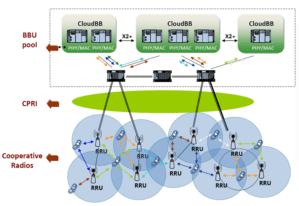Up to now, most Mobile Carriers have been following a distributed approach in their RAN network. In this type of network architecture, a single physical connection of each eNodeB to the core network is used. This solution provides a more simplified network deployment.
Centralized RAN (or Cloud RAN) is an architecture that uses co-location of resources for network optimization and enhanced performance. This approach is more suitable for 5G network development, especially when it comes down to covering specific hotspot areas.
Regarding early deployment, 5G networks should initially provide adaptable interworking across the network for both D-RAN and C-RAN connectivity. The goal is to reach a final virtualized RAN environment, where 5G RAN is partially or wholly in “Cloud,” thus providing a more flexible architecture for Mobile Carriers.
Differences between 4G and 5G deployment
Existing 4G networks support a one radio connection at a time. A single physical system is used for different services such as broadband video and machine type communications traffic. With C-RAN, multiple connections can be set up simultaneously, creating individual network slices for various service needs.
In order to provide 5G URLLC services, the 5G latency target is set up at 1 ms round trip time. Therefore, to achieve these latency constraints, the content must be moved closer to the radio. While current radio architecture is mainly in a distributed fashion, a more centralized approach will provide faster scalability and help meet 5G low latency needs.
With 5G, the first steps into the Cloud should be made gradually, moving from partially to fully “cloudified” networks and applications in the near future.
C-RAN concept
In a typical C-RAN architecture, a pool of centralized baseband resources called BBUs (baseband units) supplies digitized processed signals to remote simple cell-site elements called RRHs/RRUs (Remote Radio Heads/Units). The RRHs include analog components (PA, LNA) and typically bare-bone electronics (A/D conversion).
The BBU serves many RRHs and reduces or increase radio resource utilization as needed based on time-of-day demands and locations. The ability to manage resources across spatially distributed RRUs results in a net statistical gain, where a fixed set of resources does not need to be permanently allocated to a site.
In addition, the C-RAN architecture is better performing than distributed architectures because it offers better support for cooperative radio optimization techniques such as eICIC and CoMP. The C-RAN architecture also provides superior support for X2 handover because it occurs internally to the BBU and hence reduces the handover gap.
C-RAN interfaces
The common interfaces of interconnecting a BBU to an RRH via fiber are based on specific standards. Common Public Radio Interface (CPRI) is a standard developed by industry partners such as Ericsson, Huawei, NEC Corporation, Alcatel Lucent, and Nokia. The Open Base Station Architecture Initiative (OBSAI) was created by Hyundai, LG Electronics, Nokia, Samsung, and ZTE. These front-haul interfaces are currently widely used, however, due to significant overhead and throughput limitations, the industry is working for 5G next-generation front-haul interfaces. The CPRI consortium is currently working on a new specification known as eCPRI, where e stands for enhanced. However, ethernet solutions are also being examined.
C-RAN characteristics
Scalability & Flexibility: C-RAN will provide fast capacity expansion capabilities by the simple addition of compute nodes. Flexible allocation of functions based on each service need will be moved from local to central configurations, thus, making decisions faster and more accurate.
Agility & Programmability: Decoupling of HW and SW allows reprogramming of the hardware for different purposes. Faster introduction of new services is possible, while network slicing is also enabled for supporting different services via the same physical resources.
Efficiency: A single hardware platform can be operated independently from the RAN network. Sharing of data centers between different functions and services is possible, which will provide better utilization of baseband resources.
Incentives for Cloud RAN introduction
New revenue opportunities will arise by introducing a multi-technology platform to support new services. Using the Data Center beyond the classical Telco infrastructure will help the handling of future 5G networks. Splitting network operations into radio SW and IT-like processes will give a competitive edge for 5G Mobile Carriers.
Cloud features will evolve to handle changing traffic scenarios flexibly across RATs and further technologies. Future traffic mix of different services such as MTC and IoT will lead to increased connected users and shorter connections. As mentioned above, more demanding low-latency use cases which require processing closer to radio site can be handled more effectively with the “cloudification” of networks and services.
Enhancing the Cloud RAN portfolio further will result in flexible deployment models for 5G RAN, using BBUs either on the radio site or in a baseband “pool,” centralized fashion.
C-RAN and 5G development
In existing networks, the speed of scalability is constrained by the operational model. Deployment is still linked to hardware, and scalability is scarce due to tight and heavy operations.
Evolution to a highly scalable and software programmable network will scale the services independently and without the need for additional operations. The time to deliver new features is currently low since the architecture remains static. The requirement is to divide into a smaller and simpler set of independent services such as micro-services, which can be developed and deployed independently.
5G is about providing flexible and agile services to create value. Cloud RAN can offer some key attributes such as scalability, full automation slicing, and manageable resources.













